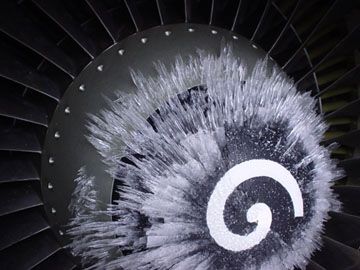Oct. 31: A Bad Day for Freezing Drizzle and Flying

Today is an anniversary of sorts for the Denver International Airport.
It's not a celebration of the installation's long-delayed opening back in 1995, however, but a studied observance of a recurring bad weather system and the damage it has wrought over the last two years.
Heavy freezing drizzle on Oct. 31 2002, and again exactly a year later, combined to cause an estimated $2.85 million in damage to 18 jet engines on United Airlines 737 aircraft waiting to take off. Meteorologists on duty in both cases failed to accurately characterize the events.
A methodology developed since then can now identify the drizzle and help officials minimize future damage.
Freezing drizzle or rain occur when liquid droplets falls on surfaces that are below 32 degrees Fahrenheit. They freeze on contact.
Roy Rasmussen of the National Center for Atmospheric Research (NCAR) has developed a new way of distinguishing between freezing drizzle and similar weather phenomena. It was announced last week.
"Freezing drizzle is hard to see and its intensity is hard to estimate visually," said Rasmussen said. "Often it goes undetected because the droplets are so small." As in half a millimeter, or roughly half the thickness of a CD.
Sign up for the Live Science daily newsletter now
Get the world’s most fascinating discoveries delivered straight to your inbox.
You might think freezing rain is a bigger problem. Not so, Rasmussen says.
Freezing rain falls to the ground quickly. But freezing drizzle takes its time coming down, so it can be sucked into an idling jet engine. The droplets freeze on contact, and ice builds up on the engine's spinning hub. When the engine is revved up to takeoff speed, ice shards are tossed into the rest of the engine. That can damage fan blades, reducing thrust.
"It's not particularly dangerous," Rasmussen said, "but they have to repair the damage, and that's very costly."
The new detection system will be installed this winter in Denver. Meanwhile, Rasmussen has worked with the airline to change procedures. Pilots used to rev engines every 30 minutes to throw of ice during freezing events (when those events were properly described by meteorologists, that is).
"Now, if anyone says 'freezing drizzle,' they do engine run-ups every ten minutes," Rasmussen said.
The research was funded by the Federal Aviation Administration.
Robert is an independent health and science journalist and writer based in Phoenix, Arizona. He is a former editor-in-chief of Live Science with over 20 years of experience as a reporter and editor. He has worked on websites such as Space.com and Tom's Guide, and is a contributor on Medium, covering how we age and how to optimize the mind and body through time. He has a journalism degree from Humboldt State University in California.












